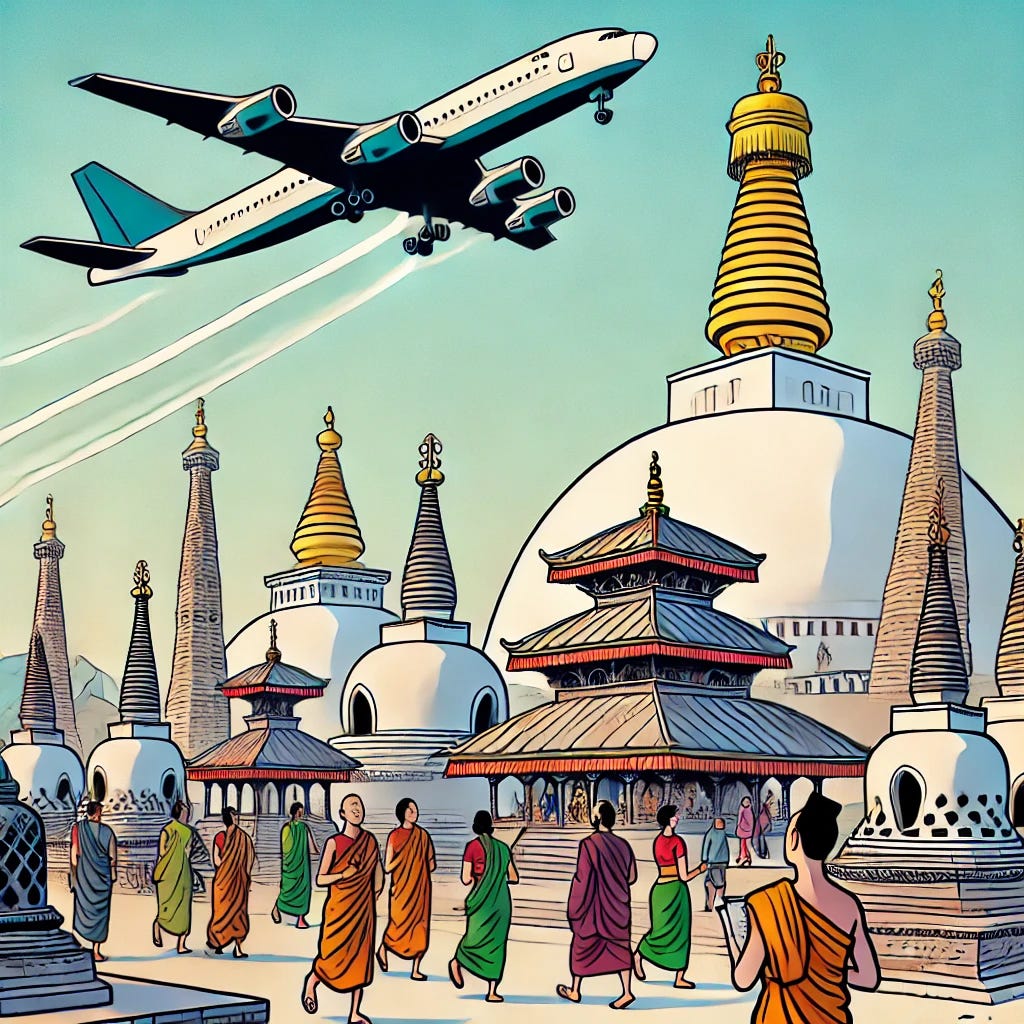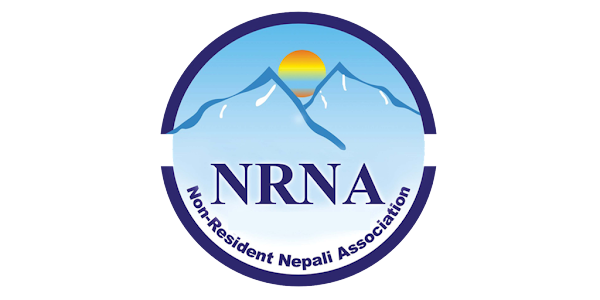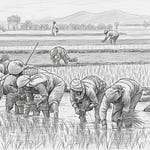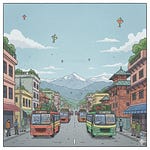This week in Nepal: Aviation takes off, energy investments grow, and governance gets a shake-up! As new international flights expand connectivity and hydropower projects secure major funding, Nepal’s electricity sector continues to evolve, with regional energy trade on the table. Meanwhile, a 12th-century Buddha sculpture returns home, marking a victory for cultural heritage, and health experts warn of rising obesity rates. In the diaspora, NRNA leadership faces legal battles, raising concerns about its future direction. And back home, the government tightens rules on foreign trips—because, apparently, junkets aren’t a national priority. Let’s dive into the latest!
Help spread the news! Let’s keep busy Nepalis worldwide informed—forward it now! 📩
Economy & Development 💸
Nepal’s aviation sector is showing promising growth, with Gautam Buddha International Airport (GBIA) in Bhairahawa seeing a record 6,800 international passengers in February, marking a steady rise in operations since flights resumed in late 2024. Four airlines—Nepal Airlines, Jazeera Airways, Fly Dubai, and Thai AirAsia—are now running regular flights, signaling increased connectivity for the region. Meanwhile, Pokhara International Airport is set to receive its first scheduled international flight to Lhasa later this month, raising hopes for boosting tourism and economic activity. However, experts remain skeptical about the sustainability of the route, citing Pokhara’s need for stronger connections to major Chinese cities or Gulf destinations to attract more travelers (Khabarhub, SCMP).

Infrastructure investments continue to expand, with Nepal securing a Rs 29.5 billion investment for the Kaligandaki Gorge Hydropower Project. This 180 MW project, expected to be completed by 2029, is a major step toward strengthening Nepal’s renewable energy sector. In parallel, Nepal and Bangladesh have advanced discussions on cross-border energy trade, with Bangladesh expressing strong interest in importing Nepal’s surplus hydropower. This partnership could be a game-changer for Nepal’s electricity market, helping reduce reliance on seasonal imports from India and boosting regional energy cooperation. Meanwhile, the Nepal Electricity Authority (NEA) posted a Rs 11.36 billion profit in six months, largely due to increased domestic consumption and electricity exports to India, reinforcing the country’s potential as an emerging energy hub (My Republica, THT).
Local economic initiatives are also gaining traction, with Mustang launching a new deluxe AC night bus service to Kathmandu, improving connectivity for both locals and tourists. Meanwhile, Kavre has started producing essential oils from Titepati and other medicinal herbs, aiming to turn the region into a hub for herbal products. With Nepal already exporting medicinal herbs worth Rs 2.25 billion last year, this initiative could further boost rural incomes and international trade. While these developments highlight Nepal’s economic progress, challenges remain, particularly in ensuring sustained international air connectivity and optimizing energy exports to fully capitalize on regional demand (Onlinekhabar, KTM Post).
Social & Cultural ⭐
In a significant cultural milestone, the Art Institute of Chicago (AIC) has returned a 12th-century sculpture, Buddha Sheltered by the Serpent King Muchalinda, to Nepal. This decision followed meticulous provenance research revealing the artifact had been illicitly removed from Guita Bahi in the Kathmandu Valley. The AIC proactively collaborated with the Nepali government to facilitate the repatriation, underscoring the importance of ethical stewardship in the art world. Sharad Raj Aran, chargé d’affaires at the Embassy of Nepal, remarked that the sculpture's return "strengthens the bond between heritage and community, ensuring future generations can connect with their history" (The Art Newspaper).
In health news, a recent report published in The Lancet projects that by 2050, half of Nepal's adult population could be overweight or obese. The study highlights a troubling rise in non-communicable diseases such as type 2 diabetes, cardiovascular ailments, and certain cancers, attributed to increasing obesity rates. Experts warn that Nepal faces a “double burden” of malnutrition, as hunger remains an issue while obesity surges, particularly in urban areas. Public health practitioners stress the need for urgent policy interventions to curb the crisis before it spirals further out of control (KTM Post).
Meanwhile, in sports, Nepal's national women's football team has climbed to 99th in FIFA’s latest rankings, moving up four spots. While still far from the top, this improvement reflects their solid performance in the recent four-nation International Women's Championship. However, with regional rivals like India ranked much higher, there’s still a long road ahead for Nepalese women’s football to break into more competitive ranks (My Republica).
Enjoying this issue? 📩 Share it with a friend & let’s keep Nepalis worldwide in the loop! Got thoughts? Hit reply—we’re all ears!
Politics & Governance 🪧
The government has begun work on the next fiscal year's budget, setting a ceiling of Rs1.9 trillion while grappling with cuts in U.S. aid, including funds from the Millennium Challenge Corporation. The Ministry of Finance is under pressure to manage resources efficiently, with officials hoping for a resumption of international support. Meanwhile, a Rs3 billion reduction in Nepal’s health budget has raised concerns over the continuity of key programs in maternal health, immunization, and epidemic control. With USAID's funding freeze, officials warn that Nepal may struggle to sustain its progress in public health, affecting everything from disease prevention to mental health services (KTM Post).
In a move to curb unnecessary foreign trips, the government has tightened restrictions on ministers and secretaries traveling abroad, citing concerns over misuse of public funds. Ministers and secretaries from the same ministry can no longer attend the same international events, and at least one-third of any delegation must be women. This policy comes amid longstanding criticisms that taxpayer-funded trips often serve little diplomatic purpose. Meanwhile, a controversial land ordinance has been put on hold after strong opposition from Madhesh-based parties, who claim the amendment would benefit land mafias. The ruling coalition is now negotiating a way forward, with some members threatening to withdraw support if their concerns are ignored (KTM Post).
Political tensions escalated as Prime Minister KP Sharma Oli challenged former King Gyanendra Shah to contest the 2084 BS elections, indirectly criticizing royalist movements calling for monarchy’s revival. Oli dismissed anti-government protests, asserting that democracy remains the only legitimate system. Meanwhile, Kathmandu Mayor Balendra Shah clashed with the central government after rejecting a directive from the Ministry of Federal Affairs regarding the appointment of a chief administrative officer. Shah's refusal to comply has reignited debates over local governance autonomy and the central government’s interference in municipal affairs (My Republica).
Did you know ❓

Did you know? The world’s first recorded tiger conservation area was established in Nepal—not in the 20th or 21st century, but in the late 18th century! During the rule of King Rana Bahadur Shah, large areas of the Terai were declared hunting-free zones to protect Bengal tigers and other wildlife. This was long before modern conservation efforts and national parks. While later rulers used parts of these reserves for royal hunting, this early initiative showed Nepal’s longstanding connection to wildlife conservation—centuries ahead of the global movement!
Diaspora & Globalization 🌎
The Non-Resident Nepali Association (NRNA) is embroiled in legal controversy after Nepal’s Supreme Court Implementation Directorate issued a directive favoring an older ruling that mandates the transfer of assets to a high-level committee led by former president Shesh Ghale. However, a later SC decision annulled the first ruling, officially recognizing the current executive body under President Dr. Badri KC. Dr. KC has strongly opposed the directive, arguing that the court administration is overstepping its jurisdiction and ignoring the second ruling. The dispute has raised concerns within the NRNA, with officials calling for legal remedies and unity through adherence to due process. Some members worry that ongoing legal battles could weaken the organization’s global influence and disrupt upcoming elections (My Republica).
Meanwhile, in a positive step for Nepal’s global academic presence, Lumbini Buddhist University (LBU) has announced plans to establish a Buddhist study center in California, offering master’s programs and short-term courses in collaboration with Enlight International Zen Meditation Centre. This initiative aims to spread Buddhist education internationally and strengthen Nepal’s cultural and spiritual connections abroad.
In another global concern, the health crisis facing Nepali migrant workers continues to escalate, with many struggling to access healthcare in host countries. While Nepal has introduced telemedicine services to offer remote medical consultations, experts argue that these initiatives remain underfunded and inaccessible to most migrants. The government is being urged to expand these services to better support the millions of Nepalis working abroad who contribute significantly to Nepal’s economy through remittances (KTM Post).
Let’s connect
Loved this issue? Share it with friends and help us keep Nepalis worldwide informed!📩 Share your thoughts! Let us know what you think via our Feedback form or follow us on Facebook | LinkedIn
About Nepali Diaspora Digest:
The Nepali Diaspora Digest connects the global Nepali community with curated news, insights, and stories that matter most. Join us as we celebrate and explore the diverse voices and achievements of Nepalis worldwide.
Partner shout out
belayat.uk: helping Nepalis connect in the UK on jobs, housing, events and finding local nepali owned businesses

















